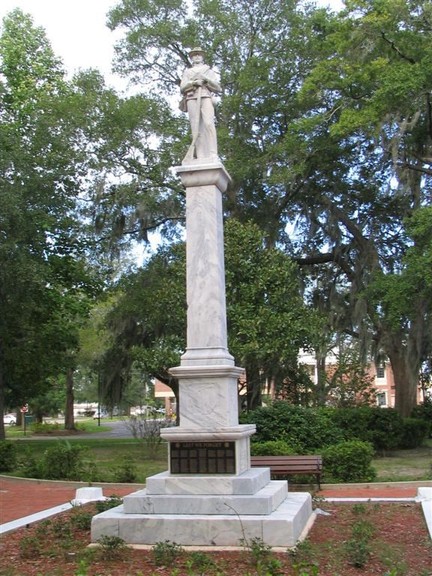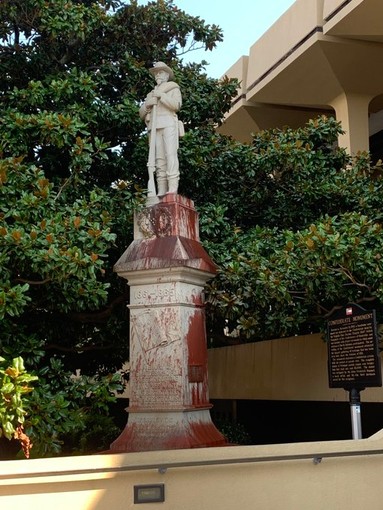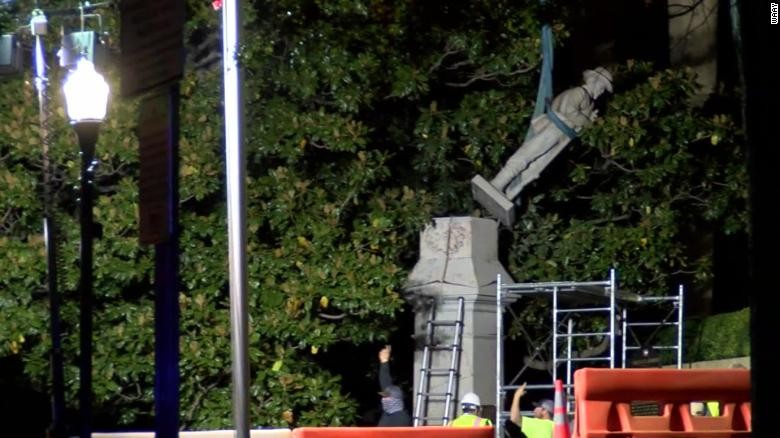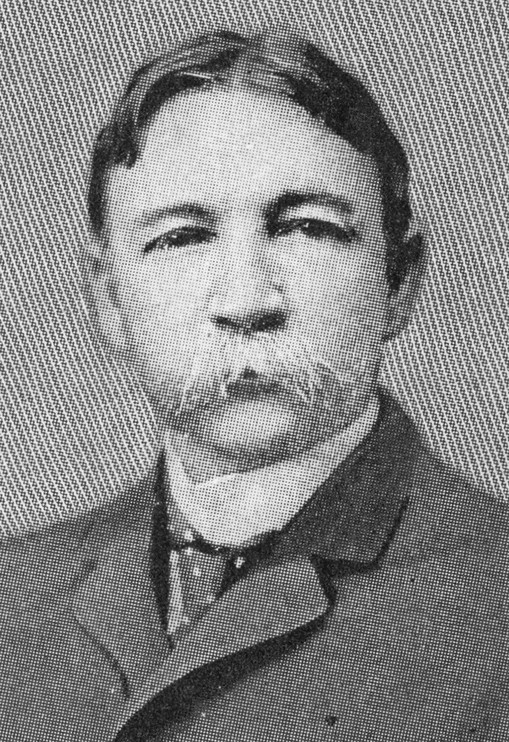Madison County Confederate Monument (1905-2020)
Introduction
Text-to-speech Audio
Images
Madison County Confederate Monument

Red paint was splattered over the Confederate monument in the summer of 2020

Crews remove the statue on the night of October 23, 2020

Governor William D. Jelks, who spoke at the monument's dedication

Backstory and Context
Text-to-speech Audio
On November 21, 1905, thousands of civilians and gray-clad veterans poured into Huntsville, Alabama for the dedication of a monument to "the memory of Confederate soldiers who fought and died in the civil war."[3] Some four hundred Confederate veterans marched through the streets, while many more--to infirm to march--looked on. At noon, the Madison County Confederate Monument was unveiled by Mrs. Virginia Clay Clopton, the president of the local Huntsville Chapter, United Daughters of the Confederacy (UDC). The crowd cheered lustily, and thirteen young girls (one for each Confederate state) placed wreaths at the foot of the monument.
A host of public officials and former Confederate leaders spoke, including Alabama Governor William D. Jelks and General George P. Harrison of the United Confederate Veterans (UCV). They were full of praise for the valor of the Confederate soldier; one speaker compared Alabama's veterans as "worthy to stand beside the Tenth Legion of Caesar, the Old Guard of Napoleon and the Light Brigade of England."[3] The ceremonies were finished with a hearty lunch provided by the UDC in the basement of the Madison County courthouse.
The Madison County Confederate Monument was typical of many from the era. Standing twenty-one feet tall, it depicts a granite Confederate soldier standing vigil atop a square obelisk base. The monument features the Confederate battle flag on the base and is inscribed: "In memory of the heroes who fell in defence of the principles which gave birth to the Confederate cause." The monument acknowledges "Our Confederate dead" and especially praises Confederate General John Hunt Morgan (born in Huntsville) as the "Thunderbolt of the Confederacy."[1] The monument cost around $2,500-3,000 to erect, and the funds were raised by the UDC.
The outpouring of Confederate veneration in 1905 masks the more convoluted political reality of Northern Alabama in 1861. Alabama seceded in January 1861 and quickly joined the Confederate States; indeed, the Confederacy's first capital was Montgomery. Despite its status as a Deep South state with a large enslaved population, however, a small but noteworthy Unionist population opposed secession. Scholar Margaret Storey estimates perhaps as many as 15% of Alabama's population were unconditional Unionists. Most of these Unionists were located in Northern Alabama, and indeed, quite a number of delegates from Northern Alabama voted against secession in 1861 for a variety of reasons. During the Civil War, Northern Alabama and Huntsville provided quite a few volunteers for both the Confederate and United States armies, notably the 1st Alabama Cavalry (U.S.).
Yet during the Reconstruction era, this legacy of Southern Unionism was often overlooked and forgotten as white Southern Democrats worked to keep white supremacy in place. Instead, groups like the UDC and UCV promoted pro-Confederate "Lost Cause" ideology. Lost Cause ideology claimed the Civil War wasn't about slavery but rather states' rights. It portrayed Confederate armies as brave and valorous (a depiction seen in the monument's text) but overwhelmed by "Yankee hordes." These Lost Cause tenets don't hold up well to scholarly scrutiny, but they are inscribed in Southern stone in monuments across the South, like the one in Huntsville.
In the 1960s, the construction of a new courthouse caused some damage to the soldier sculpture, and it was replaced through Huntsville and Madison County funds. The monument was rededicated in 1968.
In 2020, the Confederate monument came under scrutiny in the wake of nationwide Black Lives Matter protests and discussions over systemic and historic racism in the United States. The monument was vandalized, and local Black Lives Matter and other groups called for its removal. Madison County officials explored options for removal of the statue, despite resistance from the UDC. The city finally came to a decision to relocate the statue to nearby historic Maple Hill Cemetery, where a number of Confederate soldiers (including 187 unknown soldiers) are buried. On Friday, October 23, 2020, removal of the statue began in front of a small crowd of approving onlookers. As Joretha Wright commented on the removal, "It's just a nice feeling with everything that has been going on and all the tension and division, it's just nice that something like this that's caused so much chaos is actually bringing people together."[2]
Sources
1. "Confederate Soldier Monument." Smithsonian Institution Research Information System (SIRIS). Smithsonian American Art Museum. Web. Accessed October 28, 2020. https://siris-artinventories.si.edu/ipac20/ipac.jsp?&profile=ariall&source=~!siartinventories&uri=full=3100001~!328690~!0#focus
2. Kelly Murray. "A Confederate monument stood at the steps of an Alabama courthouse for a century. Now it's in a cemetery." October 26, 2020. CNN. Web. Accessed October 28, 2020. https://www.cnn.com/2020/10/25/us/alabama-confederate-statue-removed-trnd/index.html
3. "Crowd Attends the Ceremonies: Monument to Confederate Soldiers Unveiled at Huntsville." November 22, 1905. Birmingham Age-Herald [Birmingham, AL]. Digitized via Chronicling America. https://chroniclingamerica.loc.gov/lccn/sn85038485/1905-11-22/ed-1/seq-6/
4. Margaret M. Storey. "Unionism." June 26, 2013. Encyclopedia of Alabama. Web. Accessed October 28, 2020. http://encyclopediaofalabama.org/article/h-1415
5. Ashley Thusius. "Authorities Investigating Vandalism of Madison County Confederate Monument." August 5, 2020. ABC WAAY31. Web. Accessed October 29, 2020. https://www.waaytv.com/content/news/Confederate-monument-at-Madison-County-Courthouse-vandalized---572014851.html
6. "Maple Hill Cemetery." 2012. National Register of Historic Place Registration Form. National Park Service, U.S. Department of the Interior. Web. Accessed October 29, 2020. https://www.nps.gov/nr/publications/sample_nominations/AL_12000523.pdf
Waymarking.com: https://www.waymarking.com/gallery/image.aspx?f=1&guid=6782c7a9-5473-4f37-8eba-0d6778881619&gid=3
WAAY-TV: https://www.waaytv.com/content/news/Confederate-monument-at-Madison-County-Courthouse-vandalized---572014851.html
WAAY-TV & CNN: https://www.cnn.com/2020/10/25/us/alabama-confederate-statue-removed-trnd/index.html
Wikipedia: https://en.wikipedia.org/wiki/William_D._Jelks
